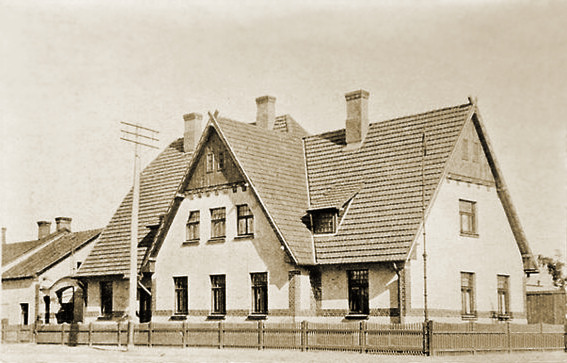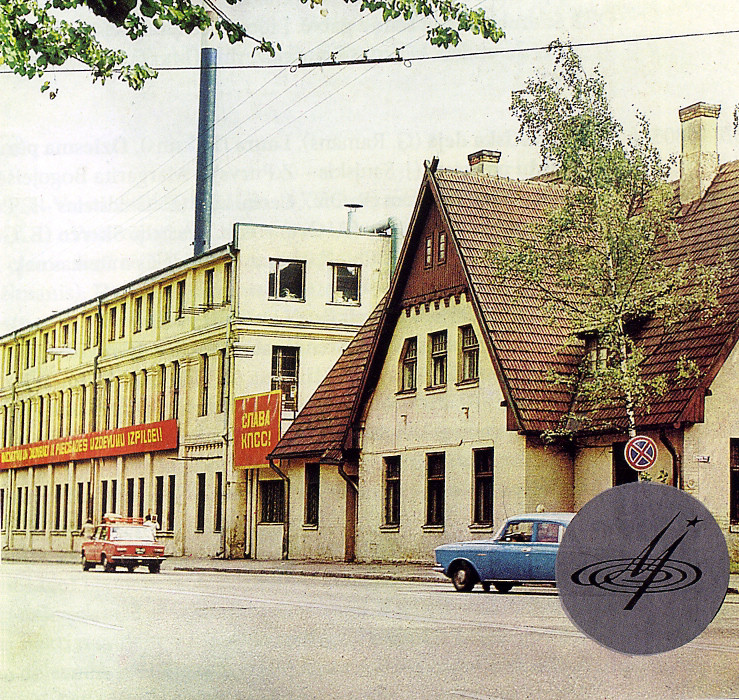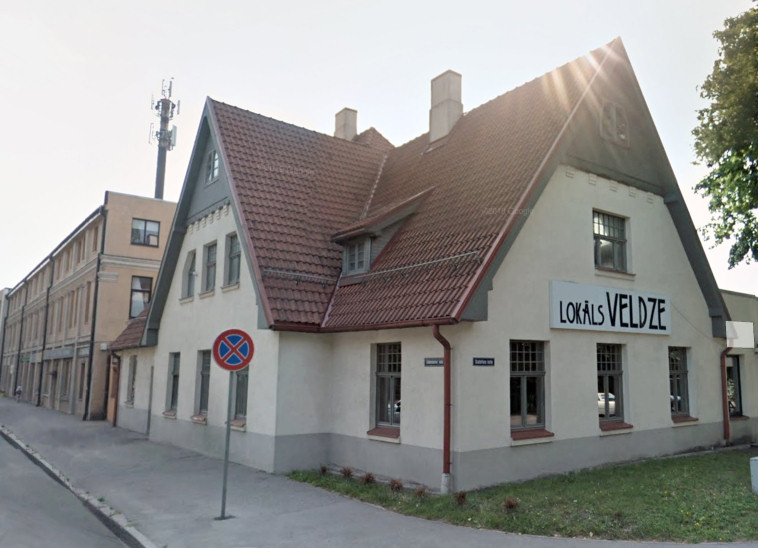|
on other languages Русский Riga gramophone records plant
The Riga gramophone records plant «Latvijas skańuplašu fabrika» is the direct successor to the Latvian label “Bellacord Electro”, which was founded in the spring of 1931 in Riga on 40 Kalnciema street. This house is a two-story building with a high tiled roof that resembles a peasant residential house. The building was erected by the famous Latvian architect Konstantin Pekshen in 1907.

|

|

|
|
«Bellaccord Electro» building then, in Soviet time and now
|
|
The founder of the Bellaccord Electro company was Helmārs Rudzītis, the owner of the largest Latvian publishing house, Grāmatu Draugs. After the Republic of Latvia was admitted to the USSR in November 1940, production was nationalized and subordinated to the People’s Commissariat of Light Industry.
The first renaming of the plant took place in May 1941, a month before the start of the Great Patriotic War (Eastern Front of the World War II). On May 23, 1941, the Decree No. 566 of the People’s Commissar of Light Industry Ed. Leitmanis was published in the Vedomosti of the Presidium of the Supreme Council of the LSSR, according to which the Bellaccord Electro factory was renamed to «Latvijas skańuplašu fabrika», Rīgā, Kalnciema ielā 40 effective May 21, 1941.
The war prevented implementation of this decree. However, at the beginning there was nationalization. In the above
"Vedomosti» from October 21, 1940 as well as in several other newspapers was published a decree on the factory nationalization. The records issued in 1940/41 years are easily identified by two letters «N.U.», that stands for «nationalized enterprise» in Latvian, as well as
by non-usage of the pre-revolutionary spelling in Russian titles. The annual number reached 160 thousand records. Began expansion of the plant and installation of new equipment. The work was interrupted by the attack of the fascist Germany. All workers capable of carrying weapons went to the front. During fascist occupation tool place the "re-privatization" of the plant and records of
that period can be identified by the abbreviation Ord, Sonder klasse, the labels were black, purple and blue color with titles on German language.
After the liberation of Riga, thanks to the help of the enterprises from Moscow and Leningrad, the plant was in a short time restored and on February 13, 1945 it resumed production of gramophone records. At this time worked on it 29 workers, 4 students and 3 persons from engineering and technical stuff. In the post-war years, the plant printed records from all-union numbering matrices sent from Moscow as well as individual Bellaccord Electro matrices from 1930s.
From 1947 to 1950 «Bellaccord Electro» studio resumed work and recorded order numbers from 4059 to 4196. The GRK permit number was aslo assigned to them. The studio recorded Latvian, Lithuanian and Estonian musical works performed by national artists (series of recordings with the letters L, E, L). As soon as 1947 the production was increased to 364 thousand records. From year to year the output keept increasing: during the first five-year post-war period the release of gramophone records increased by 3.6 times, and over the period of 1949 to 1969 ‒ by almost 20 times.
In 1950 the name «Bellaccord» have been abolished and the names «Рижский завод» «Rigas skańuplašu
fabrikã» have appeared on the labels; at the sane time the printing of records from the “Bellaccord Electro” matrixes was discontinued. However, the labels design for a long time retained the memory of the “Bellaccordian” times.
In 1957 the Plant mastered the production of long-playing records.
In August 1957 by a government decree the Riga plant «Rigas skańuplašu fabrikã», as a production company was transferred to the Council of the National Economy of the Latvian SSR (Chemical and Silicate-Ceramic Industry Directorate of the Council of the National Economy of the Latvian SSR). And quite possibly in its full name there also was «Baltija» word which was used on the labels for a short period of time.
In 1957 some «Bellaccord Electro» records from the 1930th have been restored at the studio and the plant pressed records using all-union numbering system.
In 1958 the recording studio was equipped with new imported equipment and branches were opened in Vilnius and Tallinn.
After this, 100 and more new works of Latvian, Lithuanian, Estonian composers and performers were recorded annually.
In 1958 it was renamed to «Līgo» and the full name became «Rigas skańu ierakstu un skańuplašu fabrikã» «Рижский завод грамзаписи и гампластинок». The renaming was dedicated to the national holiday Līgo. It is a traditional Latvian holiday on the summer solstice, Jāņi Day, which is similar to the Russian Ivan Kupala. The Russian collectors usually call these labels as “The Seagull” by the image of the trademark.
In August 1961 the plant was renamed to «Melodija» (Later, the name of the Riga plant was used for the newly created All-Union company «Мелодия»).
In 1962 the plant began production of stereo records.*
According to the decree of the Council of Ministers of the USSR of April 23, 1964, the plant was transferred to the Ministry of Culture of the USSR. By order of the Ministry of Culture of the USSR of July 11, 1964, the plant was included in «Мелодия» company under the name of Riga Record Plant of the All-Union Melodia Gramophone Record Company.
In 1970 the Riga Record Plant was entrusted with mastering of tape cassettes production. In order to carry out this task a branch of music cassette production was organized in Tallinn, which in 1971 produced the first 200,000 pieces, including 180,000 recorded cassettes. The plan created its own printing shop and mastered multi-color design of envelopes with cellophane coating that raised quality of their production to the level of the best world's companies that allowed to start selling abroad. The installation of envelope gluing machine replaced tedious jobs of more than 50 people.
By the centenary of V. I. Lenin birth a lot of work had been done for production of «Leninian on the record» record sets. “We treated it as a continuation of the glorious traditions of Latvian record workers: after all, in the first recordings of Lenin’s speeches made in Moscow in 1919-1921 participated Riga specialists”, wrote the plant director Juris Kambala. In December 1981, for its merits in promoting the achievements of Soviet culture and the successful implementation of production plans, the plant was awarded the "Order of the Badge of Honour" by a decree of the Presidium of the Supreme Soviet of the USSR.
The products were sold mainly in the Baltic states, in the north-west of Russia, as well as in the republics of the Soviet Union and abroad: in Bulgaria, Hungary, East Germany, Poland, Romania, the USA, Cuba, and Vietnam.
In 1992, after the collapse of the Soviet Union, the Riga Plant was privatized by Synthesis Records of Alexander Kutikov, a member of the "Time Machine" group, and renamed RiTonis. In 1993, the plant released the last record, and in 1999 the company was declared bankrupt.
The article used following sources:
- Atis Gunivaldis Bērtińš. «Latviešu skanuplašu vēsture» («History of Latvian records», Part II (1945-2015))
- Olga Dorofeeva. «Phonograph records in Riga»
- Juris Kambala. «The Riga Plant is 50 years old», «Melodia» magazine No. 1, 1982, pp. 33-34
- Wikipedia
- Website petrleschenco.ucoz.ru
- Forum «My Riga»
*The information needs documentary evidence.
|